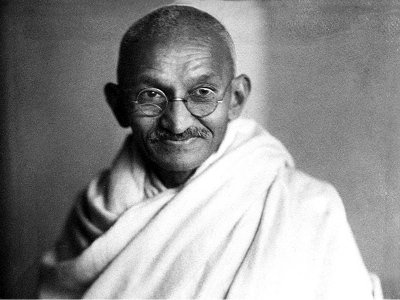Mohandas Karamchand Gandhi, widely known as Mahatma Gandhi, was a prominent Indian lawyer, anti-colonial nationalist, and political ethicist who became the primary leader of India’s independence movement against British rule.
Biography of Mahatma Gandhi: Date of Birth, Education, Career, Family, Net Worth, and FAQs
His philosophy of nonviolent resistance, known as satyagraha, inspired civil rights movements worldwide and earned him the title “Mahatma,” meaning “Great Soul” in Sanskrit.
Date of Birth and Early Life
Mahatma Gandhi was born on October 2, 1869, in Porbandar, a coastal town in present-day Gujarat, India. He was born into a Hindu merchant caste family to Karamchand Gandhi, diwan (chief minister) of Porbandar state, and his fourth wife, Putlibai. Gandhi’s childhood was influenced by the religious and cultural traditions of his family, particularly Jainism, which emphasized nonviolence, fasting, mutual tolerance, and vegetarianism.
Education
Gandhi’s formal education began in his hometown of Porbandar, where he attended primary school. His early academic performance was unremarkable, but he showed promise in subjects like English, geography, and arithmetic. In 1881, at the age of 12, Gandhi entered high school in Rajkot, where his family had moved.
Higher Education and Law Studies
In May 1883, at the age of 13, Gandhi was married to Kasturba Makhanji, who was also 13 years old. Despite his marriage, Gandhi continued his education. In 1887, he passed the matriculation examination of the University of Bombay and enrolled at Samaldas College in Bhavnagar. However, he found the college challenging and left after one term.
In 1888, Gandhi’s family decided to send him to London to study law. He enrolled at the Inner Temple, one of the four Inns of Court in London. During his time in England, Gandhi not only studied law but also explored various philosophical and religious texts, which greatly influenced his later ideologies.
Gandhi was called to the bar on June 10, 1891, and was admitted and enrolled as a barrister. He then left London and returned to India, having broadened his horizons and gained new perspectives that would shape his future career and philosophy.
Career
Mahatma Gandhi’s career was multifaceted, spanning law, activism, and politics. His professional journey took him from India to South Africa and back, ultimately leading to his pivotal role in India’s independence movement.
Early Legal Career in India (1891-1893)
After returning to India in 1891, Gandhi attempted to establish a law practice in Bombay. However, he struggled to find success due to his shyness and lack of experience in Indian law. He then moved back to Rajkot to work as a draftsman, but this too proved unsatisfactory.
South Africa (1893-1914)
In 1893, Gandhi accepted a one-year contract to work for an Indian firm in Natal, South Africa. This move marked a turning point in his career and life. In South Africa, Gandhi faced racial discrimination firsthand, which sparked his activism for civil rights.
During his 21 years in South Africa, Gandhi:
- Developed his philosophy of satyagraha (nonviolent resistance)
- Founded the Natal Indian Congress in 1894
- Fought against discriminatory legislation targeting Indians
- Established the Phoenix Settlement commune in 1904
- Led the Transvaal march against discriminatory laws in 1913
Gandhi’s experiences and achievements in South Africa laid the foundation for his future role as a leader in India’s independence movement.
Return to India and Political Career (1915-1948)
Gandhi returned to India in 1915, where he quickly became involved in local struggles and national politics. His career in India can be divided into several key phases:
- Indian National Congress (1920-1934): Gandhi joined the Indian National Congress and transformed it into a powerful instrument of Indian nationalism. He led nationwide campaigns for various social causes and for achieving Swaraj (self-rule).
- Non-Cooperation Movement (1920-1922): Gandhi launched a movement encouraging Indians to boycott British goods and institutions.
- Salt March (1930): He led a 240-mile march to the sea to protest the British monopoly on salt production.
- Quit India Movement (1942): During World War II, Gandhi launched a movement demanding immediate independence for India.
- Post-Independence (1947-1948): After India gained independence, Gandhi worked to promote peace and unity, particularly between Hindus and Muslims.
Throughout his career, Gandhi wrote extensively, publishing newspapers such as Indian Opinion, Young India, and Harijan. His autobiography, “The Story of My Experiments with Truth,” remains a classic of introspective literature.
Family
Mahatma Gandhi’s family life was complex and often intertwined with his public role and philosophy. Here’s an overview of his immediate family:
Wife
Gandhi was married to Kasturba Makhanji (also known as Ba) in May 1883. Their marriage lasted 62 years until Kasturba’s death in 1944. Despite initial difficulties due to their young age at marriage, Kasturba became Gandhi’s staunch supporter and was actively involved in his political and social work.
Children
Gandhi and Kasturba had four sons:
- Harilal Gandhi (1888-1948): The eldest son, Harilal, had a troubled relationship with his father. He converted to Islam for a brief period and later reconverted to Hinduism. His life was marked by alcoholism and estrangement from the family.
- Manilal Gandhi (1892-1956): Manilal was most aligned with his father’s values. He spent 16 years in South Africa editing the Indian Opinion and was imprisoned several times for his activism.
- Ramdas Gandhi (1897-1969): Ramdas participated in the Salt Satyagraha and was imprisoned. Later, he managed a khadi (homespun cloth) shop and worked in government service.
- Devdas Gandhi (1900-1957): The youngest son, Devdas, became a prominent journalist and served as editor of the Hindustan Times.
Extended Family
Gandhi came from a large extended family. His father, Karamchand Gandhi, had been married four times, and Gandhi had several half-siblings. His mother, Putlibai, was deeply religious and had a significant influence on Gandhi’s spiritual development.
Gandhi’s relationship with his family was often strained due to his public commitments and his adherence to his principles. He expected his family to follow his austere lifestyle and participate in his ashram experiments, which sometimes led to conflicts, particularly with his eldest son, Harilal.
Despite these challenges, Gandhi’s family played a crucial role in his life and work. Kasturba, in particular, was not just a wife but a partner in his struggles, often taking charge of the ashram in his absence and participating in civil disobedience movements.
Net Worth
Assessing Mahatma Gandhi’s net worth is a complex task due to his philosophy of simple living and his rejection of material possessions. Gandhi lived a life of voluntary poverty and owned very few personal items. However, we can consider a few aspects:
- Personal Possessions: Gandhi famously owned very little. His possessions at the time of his death included his spectacles, a pocket watch, a pair of sandals, and a few other simple items. These items, due to their historical significance, are now priceless.
- Intellectual Property: Gandhi was a prolific writer, and the royalties from his books could be considered part of his estate. However, Gandhi had assigned the copyright of his writings to various trusts and organizations.
- Trusts and Foundations: Gandhi established several trusts and foundations, including the Harijan Sevak Sangh and the Kasturbai Gandhi National Memorial Trust. While these organizations managed significant funds, they were not part of Gandhi’s personal wealth.
- Government Pension: Gandhi refused to accept any pension or payment from the government for his services to the nation.
Given Gandhi’s philosophy and lifestyle, it would be misleading to assign a monetary value to his “net worth” in the conventional sense. His true wealth lay in his ideas, his influence, and the change he brought about in India and the world.
Legacy and Influence
Mahatma Gandhi’s legacy extends far beyond India’s borders and continues to inspire people worldwide. His philosophy and methods have influenced numerous civil rights leaders and movements, including:
- Martin Luther King Jr. in the United States
- Nelson Mandela in South Africa
- Aung San Suu Kyi in Myanmar
- The Dalai Lama
Gandhi’s principles of nonviolence and civil disobedience have been adopted by various social and political movements globally. His birthday, October 2, is celebrated as the International Day of Non-Violence.
In India, Gandhi is officially honored as the Father of the Nation. His image appears on all denominations of Indian currency notes, and numerous institutions and roads are named after him.
Frequently Asked Questions
1. What were Mahatma Gandhi’s main principles?
Gandhi’s main principles included:
- Ahimsa (nonviolence)
- Satyagraha (truth-force or soul-force)
- Swaraj (self-rule)
- Sarvodaya (welfare of all)
- Simple living and high thinking
2. What was Gandhi’s role in India’s independence movement?
Gandhi played a crucial role in India’s independence movement by:
- Organizing nonviolent civil disobedience campaigns
- Uniting diverse groups under the banner of the Indian National Congress
- Negotiating with British authorities
- Inspiring millions of Indians to join the struggle for freedom
3. Why is Gandhi called ‘Mahatma’?
The title ‘Mahatma,’ meaning ‘Great Soul’ in Sanskrit, was first applied to Gandhi by Indian Nobel laureate Rabindranath Tagore. It was adopted by the public due to Gandhi’s spiritual and moral leadership.
4. What were some of Gandhi’s major achievements?
Some of Gandhi’s major achievements include:
- Leading successful civil rights campaigns in South Africa
- Spearheading the Non-Cooperation Movement in India
- Organizing the Salt March to protest British salt monopoly
- Negotiating India’s independence from British rule
- Promoting interfaith harmony and social reforms
5. How did Gandhi’s philosophy influence other leaders?
Gandhi’s philosophy of nonviolent resistance influenced numerous leaders and movements worldwide, including Martin Luther King Jr.’s civil rights movement in the United States and Nelson Mandela’s anti-apartheid struggle in South Africa.
6. What was Gandhi’s view on caste system?
Gandhi was strongly opposed to the caste system and untouchability. He worked tirelessly to eradicate these social evils and coined the term ‘Harijan’ (children of God) for the so-called untouchables.
7. How did Gandhi die?
Gandhi was assassinated on January 30, 1948, by Nathuram Godse, a Hindu nationalist who opposed Gandhi’s philosophy of nonviolence and his advocacy for Muslim rights.
8. What were Gandhi’s views on education?
Gandhi advocated for a holistic approach to education that emphasized practical skills, moral development, and self-reliance. He developed the concept of ‘Nai Talim’ or ‘Basic Education’ that integrated academic subjects with manual skills.
9. Did Gandhi win a Nobel Peace Prize?
Despite being nominated five times between 1937 and 1948, Gandhi never received the Nobel Peace Prize. The Nobel Committee publicly declared its regret for this omission in 1989.
10. What was Gandhi’s approach to religion?
Gandhi respected all religions and believed in the fundamental unity of all faiths. He drew inspiration from various religious texts but interpreted them in a rationalist and humanist light.
Conclusion
Mahatma Gandhi’s life and work continue to be a source of inspiration and study worldwide. His principles of nonviolence, truth, and social justice have left an indelible mark on history and continue to influence political and social movements. While his net worth in material terms may have been minimal, his true wealth lies in the lasting impact of his ideas and the change he brought about in India and the world.







